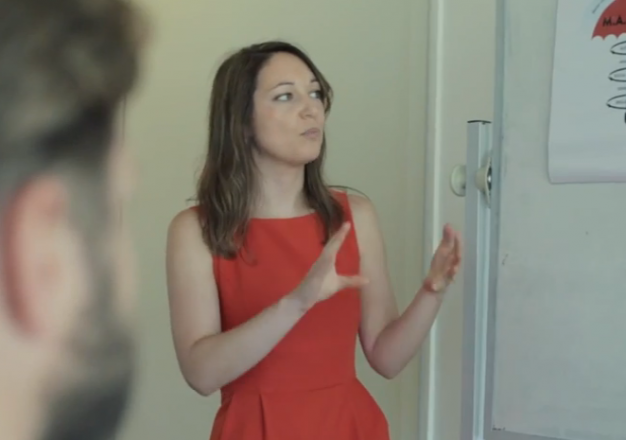The Economic Value of Social-Emotional Learning

| Posted: | August 14, 2015 |
| Author: | Aisling Mulvihill Speech-Language Pathologist |
Share this article:
Education and 21st Century Demands: How do we prepare our children for the future?
With world economies shifting and resources dwindling there is a growing awareness of the need to invest in people for long term and sustainable economic growth. Technological advances and globalisation are driving the demand for an educated, adaptive, responsible and skilled workforce. Twenty-first century companies seek to invest in a workforce of adults who set goals, have self-control, actively listen, communicate effectively, work in teams and who have the ability to persist with challenges.
So how can our education system meet these changing demands? How can the education system of today support our youth in becoming knowledgeable, responsible, caring and contributing members of society? Do our children need to have better grades? Should the educational policy focus on increasing test scores? Should our children and schools be pressed to achieve higher results in academic based measures such as NAPLAN in Australia, MAP® in the U.S. and Eleven Plus Exams in the U.K.? A recent review of the research by Levin (2012) indicated that the relationship between academic performance and a capable and competent workforce is modest. Rather the development of strong interpersonal and intrapersonal skills is linked to greater quality and productivity in the workforce and greater life success. The research of Heckman and Kautz (2012) highlighted that strong social emotional skills such as persistence, impulse control, listening skills, awareness of others and self, empathy and self-control are predictive of success in school, the labour market and in life.
While academic achievement has much value, it is only part of the picture. In setting our children up to become valuable and contributing members of society we need to move beyond the confines of such narrow measures of success. Unfortunately there appears to be a wide held belief that high test scores lead to significant economic gains (Levin, 2012). It is this belief that places unnecessary pressure on governments, schools, teachers and parents to invest their time and resources into improving achievement in subject areas at the expense of other important life skills. A paradigm shift in education that places a stronger investment in social and emotional learning will be important in creating “productive, equitable and socially cohesive societies and economic growth” (Levin, 2012, p. 279).
A paradigm shift in education that places a stronger investment in social and emotional learning will be important in creating “productive, equitable and socially cohesive societies and economic growth” (Levin, 2012, p. 279).
The Impact of Social-Emotional Challenges: What does the research tell us?
Michel’s Marshmallow Experiment – An Insight into Impulse Control:
Over 40 years ago, Walter Mischel and his colleagues from Stanford University in the U.S. studied 651 preschool-aged children examining their self-control or ‘will-power’. In their iconic ‘Marshmallow Experiment’ children were given a marshmallow and a simple choice. They were informed that they could eat the marshmallow immediately or wait for 15 minutes without eating the marshmallow and get two! In a longitudinal follow-up study, the same children were tested at 18 years of age (Mischel et. al., 1988) and 40 years of age (Ayduk et. al., 2000). The children with poor self-control who ate the marshmallow immediately were compared to the children who had good self-control and resisted the marshmallow. The results of this study indicated that impulse control and the ability to delay gratification were predictive of later academic and life successes. The children who could delay gratification for longer did better across a range of measures including higher educational achievement, attention, social skills and successful relationships, management of stress and emotion control. Brain imaging studies also showed differences in neural activation between both groups (Casey et. al., 2011).
Anger:
There is evidence to suggest that without adequate support, aggression persists over time. Research by Montague and his colleagues (2011) indicated that aggression and disruptive behaviours in the early years of schooling can persist into high school. Research by Bradshaw and her colleagues (2009) identified that high levels of aggression and antisocial behaviour early in life were associated with a range of negative life outcomes in adolescence and early adulthood including early sexual activity, teenage pregnancy, academic challenges, school dropout, unemployment and drug abuse.
Attention Deficit Hyperactivity Disorder (ADHD):
ADHD is a disorder of attention and behaviour that negatively impacts on success in learning and social interactions. The impacts of ADHD may be notable on individuals, families and society. ADHD places significant demands on a variety of public and private resources such as medical expenditure, mental health supports, educational services and the justice system. Research by Jones and Foster (2009) highlighted that over a 6 year period the service costs for children with ADHD was $25,000 greater than for children without ADHD. For children with both ADHD and identified Conduct Disorder the service costs were greater than $80,000 per child.
Bullying:
Wolke (2013) and his colleagues followed a population of students over time that were identified as bullies, victims, both or neither in an attempt to understand the long term effects of bullying. The negative effects of bullying were evident for both bullies and victims as compared to those who had no experience of bullying. This research identified that in comparison to the group that had no experience of bullying those that were both bullies and victims were 3.1 times more likely to drop out of school, while bullies were 1.6 times as likely and victims 1.1 times as likely.
Mental Illness:
As is consistent with data collected in other developed countries, data collected from the Australian Bureau of Statistics (2007) indicated that for the majority, the mental illness experienced in adult life had its beginnings in either childhood or adolescence. Over 66% of those who suffer anxiety or a mood disorder in adulthood will have had their first occurrence by the time they are 21 years old. The personal and economic costs of mental illness are found to be significant. As identified in the National Mental Health Report (2007), national expenditure on mental health services from 2006-7 in Australia was $4.7 billion, while annual losses in terms of workforce productivity due to mental illness range from $10 to $15 billion.
Growing Research on the Economic Value of Social and Emotional Learning
An ever growing body of research underscores social and emotional learning as an important factor in supporting wellbeing in childhood and later life successes. Investing in skills for life and learning in the childhood years has been shown to have positive gains for the child, the family and society at large.
In 2011, Durlak, Weissberg and their colleagues analysed 213 school-based social and emotional learning programs from around the world. Children who participated in such programs displayed significant improvements in social skills, reduced aggression and emotional distress, improved attitudes about self, others and school, and substantial gains in academic performance. An analysis of 75 recent studies of school-based social and emotional learning programs in the U.S. by Sklad and colleagues (2012) highlighted both immediate and lasting gains.
Most recently in 2015, Belfield and colleagues sought to investigate the long term economic benefits of social and emotional learning programs in schools. Within their report they analysed the cost-benefit of six prominent social and emotional interventions from the U.S. Each of the interventions showed measureable benefits that notably outweighed costs, “with an average cost-benefit ratio of about 11 to 1” (Belfield et. al., 2015, p. 5). For every dollar invested in a social and emotional learning program there was an average economic return of 11 dollars.
With growing evidence of the benefit of social and emotional learning on a personal and wider societal level, and evidence of a considerable economic return, policymakers, educators and the public can consider the incorporation of social-emotional learning into standard educational practice a wise investment in the future of a nation.
For every dollar invested in a social and emotional learning program there was an average economic return of 11 dollars.
References
Ayduk, O., Mendoza-Denton, R., Mischel, W., Downey, G., Peake, P. Rodriguez, M.L. (2000). Regulating the interpersonal self: strategic self-regulation for coping with rejection and sensitivity. Journal of Personality and Social Psychology, 79, 776-792.
Belfield, C., Bowden, B., Klapp, A., Levin, H., Shand, R., Zander, S., (2015). The economic value of social and emotional learning. Centre for Benefit-Cost Studies in Education, Teachers College, Columbia University.
Bradshaw, C.P., Schaeffer, C.M., Petras, H. Lalongo, N. (2010). Predicting negative life outcomes from early aggressive-disruptive behavior trajectories: gender differences in maladaptation across life domains. Journal of Youth and Adolescence, 39(8), 953-966.
Casey, B.J., Sommerville, L.H., Gotlib, I.H., Ayguk, O., Franklin, N.T., Askren, M.K., Jonides, J., Berman, M.G., Wilson, N.L., Teslovich, T., Glover, G., Zayas, V., Mischel, W. and Yuichi Shoda. (2011). Behavioural and neural correlates of delay of gratification 40 years later. Proceedings of the National Academy of Sciences, 108(36), 14998-15003.
Durlak, J. A., Weissberg, R.P., Dymnicki, A. B., Schellinger, K.B. (2011). The impact of enhancing student’s social and emotional learning: a meta- analysis of school-based universal interventions. Child Development, 82(1), 474-501.
Heckman, J.J. and T. Kautz. (2012). Hard evidence on soft skills. Labour Economics, 19, 451-464.
Jones, D.E., Foster, E.M., (2008). Service use patterns for adolescents with ADHD and comorbid conduct disorder. Journal of Behavioural Health Services & Research, 36(4), 436-499.
Levin, H.M. (2012). More than just test scores. Prospects: Quarterly Review of Comparative Education. UNESCO, 43(2), 269-284.
Mischel, W., Ayduk, O. (2004). Willpower in a cognitive-affective processing system: the dynamics of delay of gratification. In Naumeister R.F. & Vohs, K.D. (Eds.), Handbook of self- regulation: research, theory and applications. New York, NY: Guilford Press.
Montague, M. Enders, C. Cavendish, W., and M. Castro. (2011). Academic and behavioral trajectories for at-risk adolescents in urban schools. Behavioral Disorders, 36(2), 141-156.
Sklad, M., Diekstra, R., De Ritter, M., Ben, J., and C. Gravestein. (2012). Effectiveness of school-based universal social, emotional, and behavioral programs: do they enhance students’ development in the area of skill, behavior, and adjustment? Psychology in the Schools, 49, 892-910.
Wolke, D. Copeland, W.E., Angold, A., Costello, E.J. (2013). Impact of bullying in childhood on adult health, wealth, crime, and social outcomes. Psychological Science, 24, 1958-1970.
About the MASTER Institute
MASTER provides services, resources and guidance for parents, teachers and allied health professionals in supporting the social and emotional wellbeing of young children. Dr Deberea Sherlock and Aisling Mulvihill founded the MASTER Institute in 2012. From the combined professions of educational and developmental psychology and speech-language pathology, they bring to MASTER over 20 years of collective specialised experience in the area of children’s social and emotional development, and a deep understanding of children and the challenges they face. Their work is strongly guided by a desire to engage children through creative learning and the wider value of working collaboratively with families and schools.







